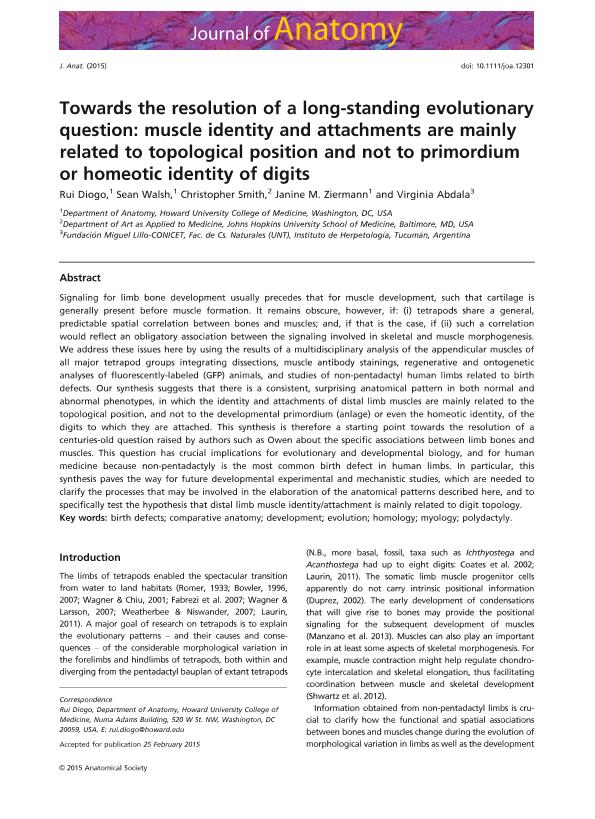Artículo
Towards the resolution of a long-standing evolutionary question: muscle identity and attachments are mainly related to topological position and not to primordium or homeotic identity of digits
Fecha de publicación:
04/2015
Editorial:
Wiley
Revista:
Journal Of Anatomy
ISSN:
0021-8782
Idioma:
Inglés
Tipo de recurso:
Artículo publicado
Clasificación temática:
Resumen
Signaling for limb bone development usually precedes that for muscle development, such that cartilage is generally present before muscle formation. It remains obscure, however, if: (i) tetrapods share a general, predictable spatial correlation between bones and muscles; and, if that is the case, if (ii) such a correlation would reflect an obligatory association between the signaling involved in skeletal and muscle morphogenesis. We address these issues here by using the results of a multidisciplinary analysis of the appendicular muscles of all major tetrapod groups integrating dissections, muscle antibody stainings, regenerative and ontogenetic analyses of fluorescently-labeled (GFP) animals, and studies of non-pentadactyl human limbs related to birth defects. Our synthesis suggests that there is a consistent, surprising anatomical pattern in both normal and abnormal phenotypes, in which the identity and attachments of distal limb muscles are mainly related to the topological position, and not to the developmental primordium (anlage) or even the homeotic identity, of the digits to which they are attached. This synthesis is therefore a starting point towards the resolution of a centuries-old question raised by authors such as Owen about the specific associations between limb bones and muscles. This question has crucial implications for evolutionary and developmental biology, and for human medicine because non-pentadactyly is the most common birth defect in human limbs. In particular, this synthesis paves the way for future developmental experimental and mechanistic studies, which are needed to clarify the processes that may be involved in the elaboration of the anatomical patterns described here, and to specifically test the hypothesis that distal limb muscle identity/attachment is mainly related to digit topology.
Palabras clave:
Birth Defects
,
Comparative Anatomy
,
Development
,
Evolution
Archivos asociados
Licencia
Identificadores
Colecciones
Articulos(CCT - NOA SUR)
Articulos de CTRO.CIENTIFICO TECNOL.CONICET - NOA SUR
Articulos de CTRO.CIENTIFICO TECNOL.CONICET - NOA SUR
Articulos(IBN)
Articulos de INSTITUTO DE BIODIVERSIDAD NEOTROPICAL
Articulos de INSTITUTO DE BIODIVERSIDAD NEOTROPICAL
Citación
Diogo, Rui; Walsh, Sean; Smith, Christopher; Ziermann, Janine M.; Abdala, Virginia Sara Luz; Towards the resolution of a long-standing evolutionary question: muscle identity and attachments are mainly related to topological position and not to primordium or homeotic identity of digits; Wiley; Journal Of Anatomy; 226; 6; 4-2015; 523-529
Compartir
Altmétricas




